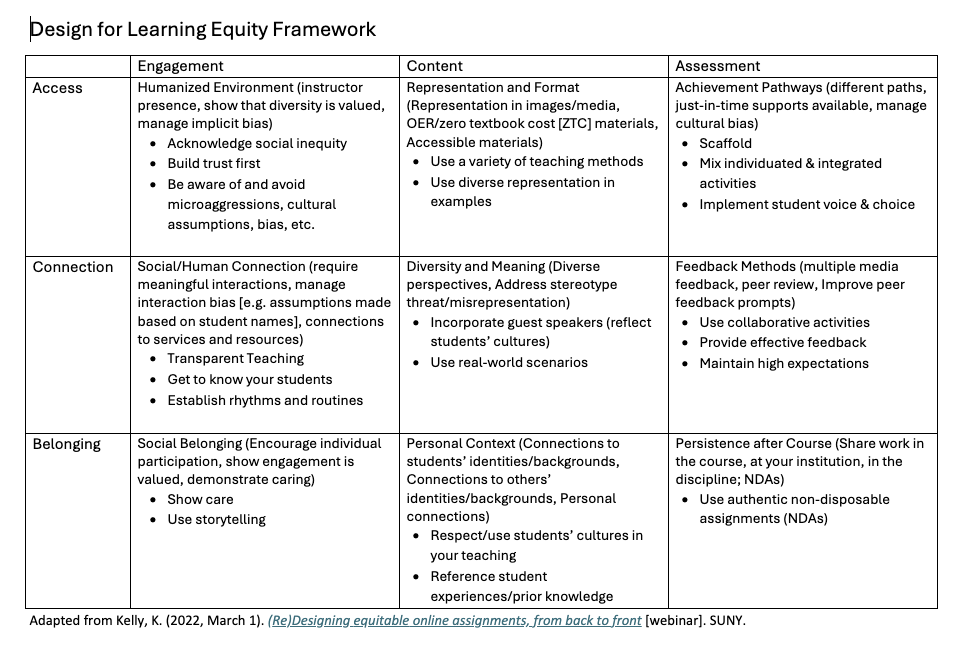by MU Instructional Designers
July 17, 2024
7-10 min read
What?
Conversations about teaching diverse students have been around for decades. You may have heard of some of the common terms for this teaching, like “multicultural education/pedagogy,” which aimed to expand students’ awareness of diverse cultures (Eakins, 2020, Gonzalez & Hammond 2017, Green & Stormont 2018).
In the mid-90s, educator and theorist Gloria Ladson-Billings argued that this mere awareness did not go far enough toward promoting equity. She coined the term Culturally Relevant Pedagogy (CRP), which recognizes and validates students’ cultures as integral to their identity while developing their ability to identify and challenge inequities in society (Ladson-Billings, 1995).
Many educators and activists have advanced Ladson-Billings’s original work and as a result we have learned more about how students see themselves as part of society. In the late 90s and early 2000s, educators like Raymond J. Wlodkowski (1995), Margery B. Ginsberg (1995), Geneva Gay (2010), and Gary R. Howard (2014) preferred to use the term Culturally Responsive Pedagogy/Teaching (CRP or CRT), which aligns with the goals of Culturally Relevant Pedagogy.
With the input of allies and advocates in more recent years, educators have built on the work of Ladson-Billings and others. In 2012, Django Paris introduced the term Culturally Sustaining Pedagogy (CSP) as part of the evolution of this work:
The term culturally sustaining requires that our pedagogies be more than responsive of or relevant to the cultural experiences and practices of young people—it requires that they support young people in sustaining the cultural and linguistic competence of their communities while simultaneously offering access to dominant cultural competence.[cite]
After exploring the evolution of terminology in this area, the instructional design team of Messiah University has opted to go with Paris’s Culturally Sustaining Pedagogy (CSP) to promote a holistic environment that recognizes the value each student brings to the classroom.
Before we dive into the implementation of CSP, we want to first establish the foundational truths that we accept for this work:
- Any student can learn and succeed academically.
- Any student can be engaged in instructional activities.
- Culture is intrinsically linked to identity and therefore impacts both teaching and learning.
- All cultures are equally valuable (the dominant culture is not superior).
Students want to learn, to be respected, and to be valued for the contributions they can make to the classroom and to society. As educators we are uniquely positioned to not just support, but encourage students to stretch just beyond where they think they can reach.
Why?
Implementing a framework like Culturally Sustaining Pedagogy (CSP) is essential for creating an inclusive environment for diverse learners. Our Biblical calling to inclusive excellence (1 Corinthians 12:12-14; John 13:35) is echoed in Messiah’s Diversity Statement:
As diverse members of the body of Christ, our shared faith compels us to work towards reconciliation with God, with each other, and with all of creation. Messiah University is dedicated to advancing diversity as a core Christian value as understood within its foundational documents in order to promote academic excellence and foster a culture of inclusion within and beyond the campus. We are committed to the process of building a community of diverse people, ideas, and perspectives that pursue intercultural competence and reconciliation in our working and learning environments. (Diversity Affairs Website)
We are a faith-based educational institution, so in addition to striving for inclusive excellence, we strive for academic excellence. From a pedagogical perspective, CSP practices are linked to academic benefits for all students:
- Increased comprehension (shared with below citations?)
- Increased engagement/interest (Abdulrahim & Orosco, 2019; Brown, 2007)
- Increased critical thinking skills (Brown & Keels, 2021)
- Increased sociocultural competence (Adams, Rodriguez, & Zimmer, 2018; Gay, 2022; Ginsberg, 2011)
How
As a community, we are committed to promoting reconciliation in church and society, but we know this isn’t a simple one-and-done task. Instead inclusive excellence is a journey, often described as having these three stages:
- Discontinuing the actual harm caused by many colonialism-based practices that linger in education (Abdulrahim & Orosco, 2019; Adams, Rodriguez, & Zimmer, 2018; Alim, Baglieri, Ladson-Billings, Paris, Rose, & Valente 2017)
- Reducing the barriers to learning that marginalized students often face (Fritzgerald, 2020; Waitoller & King Thorius, 2016)
- Empowering students to take ownership of their learning and to self-advocate in future settings (Fritzgerald, 2020; Gay, 2010; Adams, Rodriguez, & Zimmer, 2018; Brown & Keels, 2021; Conrad, 2012; Ginsberg, 2011; Hoffman, 2018; Howard, 2014; King Thorius, Cannon & Moore, 2018; Waitoller & King Thorius, 2016)
CSP practices are essential for each stage of inclusion for diverse students. It’s helpful to have a common framework to reference. In a recent webinar, Kevin Kelly shared the “Design for Learning Equity Framework,” which leverages Universal Design for Learning (UDL) principles to design equitable learning experiences that value student diversity. This was a great fit as we are already familiar with and value UDL here at Messiah.
If you’d like to learn more about CSP, you can check out our CSP annotated bibliography for further resources.
